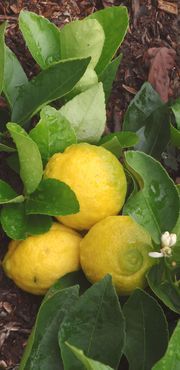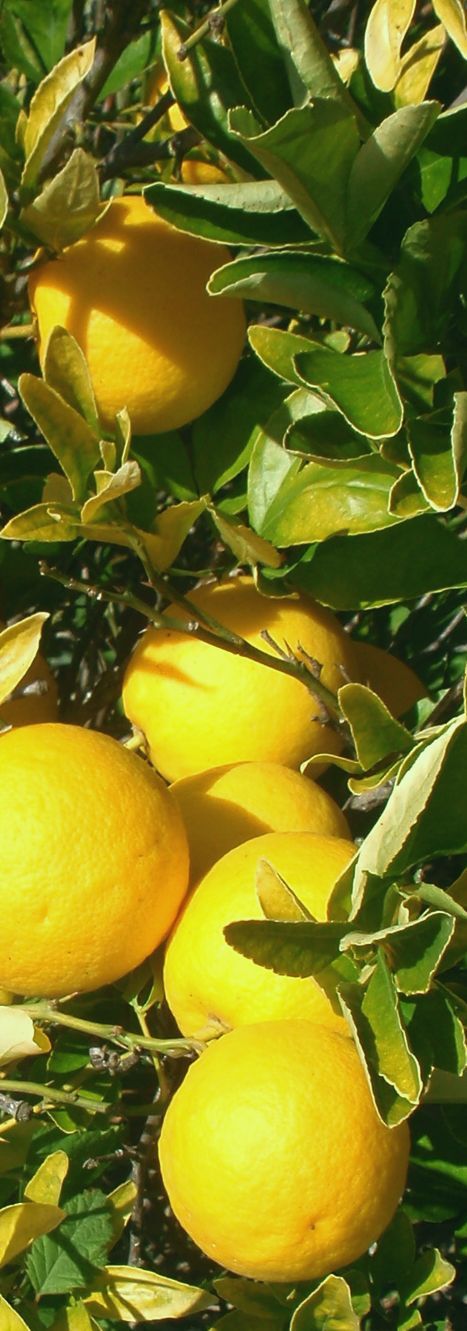|
|||||||||
Select any of 50 available languages! |
|||||||||
Trifoliate orange and rootstock
Citrus trifoliata L.
(previously Poncirus trifoliata (L.) Raf.)
 |
Trifoliate orange 'Flying Dragon'
Citrange Citrus x insitorum Citrange 'Benton' Citrange 'Carrizo' Citrange 'C-35' Citrange 'Morton' Citrange 'Rusk' Citrange 'Spaneet' Citrange 'Troyer' Citrange 'Troyer × Rangpur' Citrange 'Willits' Citrangedin 'Glen' Citrandarin Citradia Citremon Citrumelo Sacaton citrumelo Swingle citrumelo Citrangequat Citrus × georgiana Other rootstock not related to
Trifoliate orange
Why rootstock? Rootstock qualities Rootstock/scion combinations Sour orange Cleopatra mandarin Alemow (Citrus macrophylla) Rough lemon Volkamer lemon Rangpur lime Palestine sweet lime (Indian sweet lime) Sour mandarin (Citrus sunki) |
| Citrangedin 'Glen' © Jorma Koskinen |
| LAT | Citrus trifoliata L.Trifoliate orange |  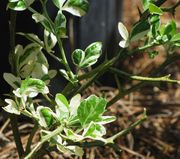 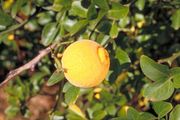 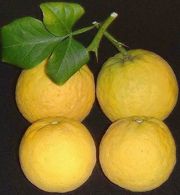  |
| Syn | Poncirus trifoliata (L.) Rafinesque Citrus triptera André Citrus trifolia Thunb. |
|
Trifoliate orange a highly distinctive deciduous shrub or small tree with very large stout spines and small compound leaves with winged petioles and three leaflets. The flower buds are small, single, lateral, protected by small fleshy scales, and are formed early in the summer preceding bloom. The flowers are very short-stalked with five white, thin, papery petals, numerous stamens of which the filaments are free, and a compound pistil. The fruits are small, oblate or obovoid to globose, and dull lemon-yellow. The rind is relatively thick, soft, densely pubescent, and has abundant oil glands. The juice is scanty and acid and the somewhat slimy pulp contains numerous droplets of acrid oil which impart a highly unpleasant taste. The seeds are plump and numerous. The fruit normally ripens in late summer or early fall and drops soon thereafter, though off-bloom fruit may mature later. Use as rootstock: Citrus trifoliata (formerly Poncirus trifoliata) is generally a good rootstock for oranges, grapefruit, most mandarins and lemons but Eureka lemon could be an exception. Cropping efficiency is good. Trees propagated on Citrus trifoliata are suitable for planting at high density. Fruit quality is excellent, with high total soluble solids and acid content and smooth thin peel. Fruit size is medium and maturity mid to late. Juice content is high. A major drawback in the use of Citrus trifoliata is the slow initial establishment of new plantings. Citrus trifoliata is the slowest growing of all commercial rootstocks. Nursery trees on Citrus trifoliata produce fruit with high early season acidity but show excellent late holding characteristics. Trees propagated on Citrus trifoliata take 6-12 months longer to grow compared with Troyer and Carrizo citranges. It is the most difficult of the commonly used rootstocks to propagate. Early spring and late autumn propagation of Citrus trifoliata are difficult due to extended winter dormancy. Small flowered selections of trifoliate orange are less vigorous than large flowered types and are more bushy. Field performance in tropical and sub-tropical regions is generally poor. Advantages: Phytophthora resistant, nematode resistant, tristeza immune, cold tolerant, tolerates waterlogging, good fruit quality, compact tree. Disadvantages: dislikes high pH soil, dislikes highly acid soil, sensitive to salinity, sensitive to calcareous soils, drought sensitive, exocortis susceptible, slow growing in nursery. |
||
| ENG | Trifoliate
orange |
|
| FRA | Poncire, Poncire commun, Oranger trifolié, Citronnier trifolié. | |
| DEU | Dreiblättrige Bitterorange | |
| I TA | Egle | |
| ESP | Limonero trifoliado, Naranjo trébol | |
| Photos | (1,4) © Home Citrus
Growers (2) © Laaz (3,5) © C. Jacquemond / INRA |
|
| Link | Home Citrus Growers | |
| LAT | Citrus trifoliata 'Rubidoux' |   |
| Syn | ||
At the present the only Citrus trifoliata clone whose behaviour is sufficiently well established to warrant naming is Rubidoux. The parent tree was planted on the old Rubidoux site of the University of California Citrus Research Center, Riverside, about 1907 and came from the R. M. Teague Nursery Company at San Dimas, California. While it belongs to the small-flowered group and has medium vigour in comparison with others, there does not seem to be another cultivar to compete with it. |
||
| ENG | Trifoliate
orange 'Rubidoux' |
|
| FRA | ||
| DEU | ||
| Photos | © C. Jacquemond
/ INRA © CCPP |
|
| LAT | Citrus trifoliata L. var. monstrosa T. Ito Flying Dragon |      A blossoming Flying Dragon |
| Syn | Poncirus trifoliata var. monstrosa (T. Ito) Swingle |
|
Flying Dragon. Several dwarfed ornamental varieties are said to exist in the Orient. The most important and interesting of these is the Japanese hiryo or Flying Dragon variety, introduced to the United States in 1915. Grown primarily as a potted plant, this is a highly dwarfed variety with very small leaves, the leaflets of which are commonly reduced to linear filaments, and slender crooked branches armed with large, downward-curved spines. It is a curious monstrosity, which has been accepted as the botanical variety monstrosa of T. Ito. The tree is a bushy, rounded, deciduous shrub with green twisted stems armed with sharp spines. White flowers in late spring and early summer followed by small orange-like fruit. One of the traits of the Flying Dragon is that it is equally attractive in winter when it sheds its leaves. The twisted branches that intertwine into each other have almost an almost menacing look. The Flying Dragon is also used as rootstock especially for potted varieties. It is the most dwarfing of the known rootstock varieties, i.e. the plants grafted on to Flying Dragon remain small in size and never demand large space. The fruit borne are also somewhat smaller but of high quality. The fruit of the rootstock itself are inedible and have no culinary use. The bottom picture taken by Gene Lester on March 14, 2011 depicts a Flying Dragon bush that blossoms and leafs at the same time, a rare occurrence. |
||
| ENG | 'Flying
dragon' trifoliate orange |
|
| FRA | ||
| DEU | ||
| Photos | (1) © C. Jacquemond
/ INRA (2) © Laaz (3-4) © Jorma Koskinen (5) © Gene Lester |
|
| Link | ||
Trifoliate orange hybrids
Citrus × trifoliata
| LAT | Citrus × insitorum Mabb. Citrange |  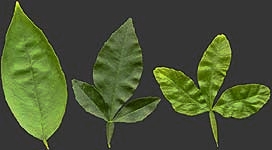  |
| Syn | XCitroncirus webberii J. Ingram & H.E. Moore Citrus sinensis (L.) Osbeck × Citrus trifoliata L. |
|
Citrange. The influence of the trifoliate orange is strongly marked in the citranges as evidenced by the trifoliate nature of their leaves, the acidity and bitterness of their fruits, and the cold-hardiness of the trees. The influence of the sweet orange is shown, however, in the evergreen nature of the trees, though a few are semi-deciduous, and in their greater vigour. The fruit is also usually much larger and more orange-like in appearance. In general, however, the citranges exhibit some degree of intermediacy between the parental species. Of great horticultural importance in connection with their use as rootstocks is the fact that with few exceptions they come remarkably true from seed. The picture in the middle, taken by Mike Saalfeld, nicely shows the intermediate position the citrange (middle) between sweet orange (left) and trifoliate orange (right) Use as rootstock: Since the citranges generally exhibit some of the most desirable features of the trifoliate orange combined with the greater vigour and wider range of soil adaptation of the sweet orange, some of them are currently of promise or have already achieved importance as rootstocks. Principal among these are Benton, Carrizo, C-35, Morton, Rusk, Troyer and Willits, which are described below. |
||
| ENG | Citrange |
|
| FRA | ||
| Photos | (1) © Petr
Broža (2) © Home Citrus Growers (3) © C. Jacquemond / INRA |
|
| Link | Home Citrus Growers | |
| LAT | Citrus × insitorum Mabb. 'Benton' | 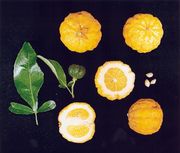 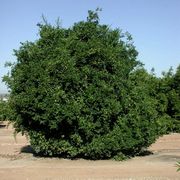 |
| Syn | XCitroncirus webberii J. Ingram & H.E. Moore Citrus trifoliata L. × Citrus sinensis (L.) Osbeck 'Ruby' |
|
| Benton citrange. In
1945, a
citrus rootstock breeding programme was initiated by Dr. F T Bowman of
NSW Agriculture, in an attempt to obtain rootstocks compatible with
Eureka lemon that were also Phytophthora resistant and tolerant of
Citrus tristeza virus. From this programme, the Benton citrange, a hybrid of Ruby Blood sweet orange and P. trifoliata, was selected and has performed well as a rootstock for Eureka lemon in a number of replicated trials on the Central Coast of New South Wales, Australia. With Eureka lemon it produces trees of an intermediate size with good cropping efficiency. Being relatively compact they are more manageable than trees on the more vigorous Rough lemon. Possibly a later maturity time than that of Rough lemon. When used as a rootstock for Eureka, Fino and Verna lemons, Benton was a top performer in field experiments. Promising early results have been obtained in Queensland with certain mandarin varieties, giving high yields and good fruit quality. Longer term Australian results with oranges have been less encouraging. Advantages: Phytophthora tolerant, tristeza tolerant, good fruit quality, compatible with Eureka lemon, good cropping efficiency, good fruit quality. Disadvantages: can be difficult to bud, not suitable for calcareous soils, sensitive to salinity. |
||
| ENG | Benton
citrange |
|
| FRA | Citrange Benton | |
| Photos | © Citrus Australia
Limited © CCPP |
|
| Links | ||
| LAT | Citrus × insitorum Mabb. 'Carrizo' |    |
| Syn | XCitroncirus webberii J. Ingram & H.E. Moore Citrus trifoliata × Citrus sinensis 'Washington Navel' |
|
Carrizo and Troyer citranges are hybrids of Washington navel orange and Poncirus trifoliata. The original crosses were made in the early 1900s by the United States Department of Agriculture with the intention of producing cold-tolerant scion varieties. Carrizo is almost indistinguishable from Troyer and of the same parentage. Savage and Gardner (1965) have presented convincing evidence that Carrizo and Troyer are in fact a single clone, which originated as the zygotic seedling from a cross of Washington navel and trifoliate orange instead of two sister seedlings as had been assumed (Mortensen, 1954). Carrizo and Troyer use as rootstock: Mature trees are medium to large. Young trees on these stocks are vigorous and produce good crops of high quality fruits in their early years. Fully compatible with navel and Valencia orange varieties, but it could be incompatible with Eureka lemon, forming a yellow ring at the bud-union that could be caused by something else. Crop regulation should be considered an essential management requirement for mandarin cultivars grown on these rootstocks. Fruit quality is excellent, but there is a tendency for increased albedo breakdown in older trees. Fruit size is medium, with a thin, smooth rind. Juice and sugar content are high and acidity levels are medium to high. Fruit maturity is earlier than Poncirus trifoliata, Swingle citrumelo and Cleopatra mandarin but later than Rough lemon. Advantages: Phytophthora tolerant, nematode tolerant, Tristeza tolerant, cold tolerant, highly polyembryonic, moderately vigorous. Disadvantages: dislikes high pH soil, dislikes clay soil, sensitive to salinity and waterlogging, sensitive to calcareous soils, overgrows mandarin scions. |
||
| ENG | Carrizo
citrange |
|
| FRA | Citrange Carrizo | |
| Photos | © Home Citrus Growers © Aggie Horticulture TAMU © CCPP |
|
| Link | Home Citrus Growers | |
| LAT | Citrus × insitorum Mabb. 'C-35' |    |
| Syn | XCitroncirus webberii J. Ingram & H.E. Moore Citrus trifoliata L. × Citrus sinensis (L.) Osbeck 'Ruby' |
|
C-35 citrange is a result of crossing Trifoliate orange (Poncirus trifoliata 'CRC 2552') with a 'Ruby' sweet orange (Citrus sinensis 'Ruby CRC 589'). The cross was made by J.W. Cameron & R.C. Baines in the Citrus Research Center, Riverside, CA, in 1951. C-35 citrange is a common citrus rootstock. It reduces the size of the tree while not limiting the production. It is used widely on navel oranges because of its excellent yield efficiency i.e. for each cubic metre of canopy volume, it produces more kilograms of fruit than other rootstocks. Good performance has also been obtained on grapefruit, valencia oranges and clementines. Advantages: Phytophthora tolerant, drought tolerant, nematode resistant, cold tolerant, tristeza tolerant, good fruit quality. Disadvantages: dislikes clay soil, sensitive to high salinity. |
||
| ENG | Citrange
C-35 |
|
| FRA | Porte greffe citrange C-35 | |
| Photos | (1-2) © C. Jacquemond
/ INRA (3) © Vogel R. / INRA |
|
|
|
||
| LAT | Citrus × insitorum Mabb. 'Morton' |  |
| Syn | XCitroncirus webberii J. Ingram & H.E. Moore Citrus trifoliata × Citrus sinensis 'Ruby' |
|
Morton citrange. Morton is another Ruby orange × Trifoliate orange cross made by Walter T. Swingle. He named it in 1913 in honor of Julius Sterling Morton (1832 -1902), a former Secretary of Agriculture. Of all the citrange types 'Morton' has been reported to bear fruit that approach edibility. Certainly on the Internet there are reports from citrus enthusiasts and other people who grow their own citrus saying the fruit they have grown could be eaten fresh "out-of-hand". This surely depends on growing conditions. Many people growing cold-hardy citrus varieties in cooler climates have been disappointed when expecting sweet fruit. However, in all citrus areas Morton citrange is valued for making lemonades and mixed drinks and it is also good for pies, marmalade and jams. Several studies show that naturally sweet citrus types like sweet oranges and mandarin produce high sugar content on Morton citrange rootstock. Use as rootstock: properties similar to Carrizo and Troyer, but sugar/solids content is reported to be higher. |
||
| ENG | Rusk
citrange |
|
| FRA | Citrange Rusk | |
| DEU | ||
| Photos | © Steve Katzberg | |
| Links | ||
| LAT | Citrus × insitorum Mabb. 'Rusk' | 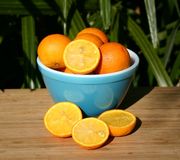  |
| Syn | XCitroncirus webberii J. Ingram & H.E. Moore Citrus trifoliata × Citrus sinensis 'Ruby' |
|
Rusk citrange, a Ruby orange and trifoliata hybrid, is one of the oldest citranges, having been created by Swingle in 1897 and described and released in 1905 (Webber and Swingle). It was named in honour of J. M. Rusk, the first Secretary of Agriculture of the United States. Tree is vigorous, tall growing, productive, and hardy; foliage evergreen to semi-deciduous and dense, consisting of moderately large trifoliate leaves. Fruit rather small, oblate to spherical; smooth and virtually glabrous; colour deep orange with reddish flush. Rind thin and tightly adherent; segments about 10. Flesh colour orange-yellow; very juicy; flavour sprightly acid and only slightly bitter. Seeds few and highly polyembryonic. Early in maturity. Rusk yields juice valued for soft and mixed drinks. It is also useful for pies, jams and marmalade. |
||
| ENG | Rusk
citrange |
|
| FRA | Citrange Rusk | |
| DEU | ||
| Photos | © Jeff Stevens
© Agrumi Voss |
|
| Links | Hardy Citrus at Southeastern Palms | |
| LAT | Citrus × insitorum Mabb. 'Spaneet' |   |
| Syn | XCitroncirus webberii J. Ingram & H.E. Moore |
|
The fruit of Spaneet is similar to Willits with is rough and deeply corrugated surface. Ripe fruit have a deep reddish orange rind colour like Rusk. Spaneet has very few seeds and is vigorous and productive. |
||
| ENG | Spaneet
citrange |
|
| Photos | © Jorma Koskinen |
|
| LAT | Citrus × insitorum Mabb. 'Troyer' |   |
| Syn | XCitroncirus webberii J. Ingram & H.E. Moore Citrus sinensis (L.) Osbeck 'Washington Navel' × Citrus trifoliata L. |
|
Troyer citrange originated as a hybrid of the Washington navel orange crossed with trifoliate orange pollen that was made at Riverside, California in 1909. In 1934, Swingle named it for A. M. Troyer, on whose place at Fairhope, Alabama, it first fruited. The rise of this rootstock to prominence in California has been spectacular. Within less than twenty-five years from the first field trial it had become the rootstock most employed and is much in demand elsewhere. Tree is vigorous, upright spreading, and medium-large with rather slender, thorny branchlets; foliage moderately dense, evergreen to semi-evergreen. Leaves dark green, medium in size, and mainly trifoliate, occasionally unifoliate. Productive and hardy. Use as rootstock: See Carrizo |
||
| ENG | Troyer
citrange |
|
| Photos | © CCPP |
|
| LAT | Citrus × insitorum Mabb. 'Troyer × Rangpur'' |  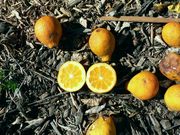  |
| Syn | XCitroncirus webberii J. Ingram & H.E. Moore × (Citrus × jambhiri Lush. 'Rangpur') (Citrus sinensis (L.) Osbeck 'Washington Navel' × Citrus trifoliata L.) × (Citrus × jambhiri Lush. 'Rangpur' ) |
|
This is a new rootstock variety, a hybrid of Troyer and the Rangpur lime. It produces prolifically, perhaps more so than the regular citrange varieties. It also tastes different having more of the Rangpur flavour in it. Gene Lester says it makes an excellent lemonade. What sets it apart from citranges and Rangpur is its peculiar long neck, rather a curiosity and of some decorative value. The fruit ripen to a dull orange colour. It should be somewhat cold-resistant. Information from the UC Riverside Citrus Collection: "M Roose reports that this is a desired
rootstock and may be needed for industry trial release in California.
Tentative plan is to process for the variety collection...foundation
set + CB at Lindcove. M Roose also [says] that this accession is
Phytophthora resistant to a degree." (EM Nauer, 04/1988) ... "In the
nursery it produces vigorous, unbranched seedlings which are easy to
bud. Seedling tests indicate that it is more susceptible to
Phytophthora parasitica than Carrizo, but survival of field trees has
been excellent. It is resistant to tristeza but susceptible to
exocortis...Soil adaptation is not yet well characterized, but it has
grown well on a wide rnage of soils in Florida...[Trees] grown on [this
accession] have a moderate growth rate resulting in trees 50 - 75 % of
the height of those on Carrizo. We believe its overall effect on tree
size will be simialr to that on C-35 citrange. Yield relative to tree
size is good to excellent in most trials [as is fruit quality]. Trees
on this cultivar also showed moderate cold tolerance under Florida
conditions. Overall it appears to be a rootstock worth of trial in
higher density plantings. On the other hand it has not known advantages
over C-35 citrange and somewhat poorer disease resistance." (ML Roose,
"New Rootstock Cultivar Descriptions", CCNS Newsletter, Spring 1991,
summarizing Castle et al, Proc Fla Hort Soc, 99:33-35, 1986). (RRK,
09/2006)"
|
||
| ENG | Troyer × Rangpur
citrange |
|
| Photos | © Gene Lester |
|
| LAT | Citrus × insitorum Mabb. 'Willits' |  |
| Syn | XCitroncirus webberii J. Ingram & H.E. Moore Citrus sinensis (L.) Osbeck 'Ruby' × Citrus trifoliata L. |
|
Willits citrange is a result of crossing Trifoliate orange (Citrus trifoliata) with a 'Ruby' sweet orange (Citrus sinensis 'Ruby'). The cross was made by W.T. Swingle at the USDA in 1913. The fruit is very ornamental, rough skinned and yellowish-orange in colour. Willits sometimes has a tendency to produce fingered fruits with irregular shape. |
||
| ENG | Willits
citrange |
|
| FRA | Citrange Willits | |
| Photos | © Agrumi Voss | |
|
|
||
| LAT | Citrangedin 'Glen' |    |
| Syn | (Citrus × microcarpa Bunge) × (Citrus × insitorum Mabb. 'Willits') |
|
|
Glen citrangedin This complex hybrid is the result of a cross of the Calamondin, itself a hybrid of a kumquat Citrus japonica and the sour mandarin Citrus sunki, with the 'Willits' citrange, a hybrid of Citrus trifoliata and a 'Ruby' sweet orange. The Glen citrangedin received its name from the town of Glen St. Mary, Florida where much of the breeding work was done. It bears small, subglobose fruits of a brilliant orange-yellow color. The 4-specific hybrid often shows one- or two-lobed leaves on young vigorous shoots, and sometimes difoliolate or trifoliolate leaves. The leaves on fruiting twigs are almost always unifoliolate and look much like those of other kumquat hybrids. This hybrid shows clear traces of all the varieties in its parentage but is strikingly different from any kumquat, trifoliate, mandarin or sweet orange varietiey. So strikingly distinct is its appearance that if the parentage as a complicated hybrid of several well-known citrus varieties was not known, the Altamaha or Glen citrangedin might easily be thought of as a candidate for a new species if it was unexpectedly "discovered" by a casual citrus variety hunter. |
||
| ENG | Glen citrangedin, Altamaha citrangedin |
|
| FRA | ||
| Photos | © Jorma Koskinen | |
| LAT | Citrandarin (Tanaka) |    |
| Syn | Citrus reticulata Blanco × Citrus trifoliata L. |
|
Citrandarin is a cold-hardy intergeneric hybrid of Citrus trifoliata (Trifoliate Orange) and Citrus reticulata (Mandarin). Cold-hardiness: can tolerate down to +10 F (- 12 C) for short durations depending upon cultivar and/or individual seedling variation. Top picture is a Citrandarin C-40197 from Corsica, middle picture is a 'Changsa' and bottom a 'Shekwasha' citrandarin, both from Oklahoma City, OK. |
||
| ENG | Citrandarin |
|
| FRA | Citrandarin | |
| DEU | ||
| I TA | ||
| ESP | ||
| Photos | (1) © C. Jacquemond
/ INRA (2,3) © Don's Citrus Blog |
|
| Link | ||
| LAT | Citradia |   |
| Syn | Citrus aurantium L. × Citrus trifoliata L. |
|
|
Citradia s a cross of sour orange and trifoliate orange. Citradias have trifoliate leaves and look very much like citranges. They combine the cold hardiness of both parents are said to be more vigorous and in some cases hardier than either one. |
||
| ENG | Citradia |
|
| FRA | Citradia | |
| Photos | © Jorma Koskinen | |
| LAT | Citremon (Tanaka) |   |
| Syn | Citrus limon (L.) Burm. × Citrus trifoliata L. |
|
|
Citremon is a cross of lemon and trifoliate orange. |
||
| ENG | Citremon |
|
| FRA | Citremon | |
| Photos | © Jorma Koskinen | |
| LAT | Citrumelo (Tanaka) |   |
| Syn | Citrus paradisi Macf. × Citrus trifoliata L. |
|
Citrumelo is a cross of grapefruit and trifoliate orange. The pictures are of Citrumelo 4475, a Duncan grapefruit × Citrus trifoliata cross selected in 1907 in Eustis, Florida by W.T. Swingle. The then most popular Duncan was the pod parent of most early citrumelo crosses, where the trifoliate orange was the pollen parent. The purpose was to transfer the cold resistance of the trifoliate to grapefruit but the fruit produced were inedible and this hybrid was forgotten. Later in the 1940s citrumelo 4475 was tested as rootstock and the results were promising. It was tested in many countries and was found to be both tristeza and phytophthora resistant. The variety was released in 1974 as Swingle citrumelo, see below. |
||
| ENG | Citrumelo |
|
| Photos | © Jorma Koskinen |
|
| LAT | Citrumelo (Tanaka) 'Sacaton' |   |
| Syn | Citrus paradisi Macf. × Citrus trifoliata L. |
|
Sacaton citrumelo was discovered by W.T. Swingle in 1919 in Sacaton, Arizona while he was working for the USDA. It too is a cross of grapefruit and trifoliate orange, but of unknown cultivars. According to The Citrus Industry "Sacaton produces large numbers of seeds containing only nucellar embryos and consequently yields identical seedlings in great numbers, like the Troyer citrange." However, more recent studies have shown Sacaton to have between 40-50% zygotic seeds. Sacaton citrumelo is used in many countries as a rootstock variety. |
||
| ENG | Sacaton citrumelo |
|
| Photos | © Jorma Koskinen |
|
| LAT | Citrumelo 'Swingle' | 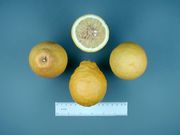  |
| Syn | Citrus paradisi 'Duncan' Macf. × Citrus trifoliata L. |
|
Swingle citrumelo is a hybrid of Duncan grapefruit and Poncirus trifoliata produced in 1907 in Florida and released by the United States Department of Agriculture in 1974. Use as rootstock: Phytophthora (foot rot) and nematode tolerance of Swingle citrumelo makes it suitable for replant sites. Trees grown on Swingle are vigorous, large and produce intermediate to high yields depending on cultivar. High early yields with navel oranges have been reported. Ability to hold fruit on the tree is good. Swingle rootstock produces fruit with high juice and soluble solids content and mid-range acidity. Fruit matures mid-late season and rind colour development of navel oranges on Swingle is delayed. Swingle citrumelo is a superior rootstock for grapefruit producing high yields of large, excellent quality fruit with high juice content. Valencia yields on Swingle are moderate. Swingle citrumelo is sensitive to high chloride levels in soil and irrigation water but is more salt tolerant than other trifoliate hybrids such as Carrizo and Troyer citranges. Swingle has a tendency to overgrow most orange scion cultivars. Swingle is incompatible with Eureka lemon and is not recommended for Imperial mandarin due to cincturing and overgrowth at the bud union. It is incompatible with Meyer lemon. Advantages: Phytophthora resistant, drought tolerant, nematode resistant, tristeza tolerant, cold tolerant, highly polyembryonic. Disadvantages: dislikes high pH soil, dislikes clay soil, sensitive to salinity and waterlogging, sensitive to calcareous soils, overgrows orange scions. |
||
| ENG | Swingle
Citrumelo |
|
| Photo | © Aggie Horticulture TAMU © CCPP |
|
| LAT | Citrus x georgiana Mabb. 'Citrangequat' |   |
| Syn | (Citrus x insitorum Mabb) × Citrus japonica Thunb. Citrus trifoliata L. × (Citrus × sinensis Osbeck) × Citrus japonica Thunb. X Citroncirus webberi × Citrus japonica sp. |
|
Citrangequats are crosses of citrange and kumquats. They resemble the kumquat parent more and are described in kumquats. See: > Citrangeguat > Citrangequat 'Thomasville' > Citrangequat 'Sinton' |
||
| ENG | Citrangequat |
|
| FRA | Citrangequat | |
| Photos | © C. Jacquemond
/ INRA © Petr Broža |
|
Other rootstock not related to Citrus trifoliata
Why rootstock?
 |
Citrus
plants grown in the "normal" way from seedlings have several problems?
Due to the complicated and in part fascinating sex life of citrus
plants a tree grown from a zygotic seed (a sexually produced seed that
has the genes of both parents) seldom grows true-to-type. An example:
the seed of two pink-fleshed fruit can grow into a fruit with white
flesh or another citrus type completely. While many citrus trees grow
true these seedlings take up to 7 - 12 years before they grow a trunk
and a rootsystem strong enough to bear fruit. On top of that many
highly hybridised modern citrus types (the ones that have two sets of
genes from both parents, i.e. hybrids of hybrids) have lost their
immunity to disease and are highly susceptible to many viruses and
other pathogenes. Many commercially grown citrus types grown from seed
have big thorns and are not well-adapted to various kinds of soils and
other growing conditions. Many natural non-hybrid citrus types grown
for rootstock have fewer and smaller thorns and they have retained
their immunity and are more tolerant of different growing environments. |
 |
Rootstock
qualities
Practically all commercially grown citrus types
are budded or grafted on to rootstock. The best scion/rootstock
combinations can produce fruit in 3-4 years in optimal conditions.
Because various citrus types have different requirements the use of
rootstock enables the combination of best scion (the fruit-bearing
hybridised part) to best rootstock for the local conditions, which vary
from place to place, climate to climate. More than 20 different
qualities can determine the choice of rootstock. Some of the most
important are:* tree vigour * rooting depth * time to reach fruit maturity * fruit yield, size, quality and sugar/solids content * cold tolerance * flood and water logging tolerance * adaptation to salinity, alkalinity, calcareous soils * resistance to nematodes, foot rot (phytophthora), citrus blight * susceptibilty to citrus tristezza (CTV), citrus exocortis (CEV) and citrus xyloporosis (CXV) viruses |
 
|
Because of different combinations of these characteristics the Swingle citrumelo is the most widely grown rootstock in Florida while 95 percent of citrus trees in Texas grow on Sour orange rootstock. On the other hand in California due to the wide range of growing conditions in different parts of the state, high number of citrus cultivars grown and varying threats of disease from place to place practically all of the rootstock varieties on this page are used. Australia, South America and the Mediterranean states all have their own profiles of suitable rootstock. Rootstock/scion
combinations
Fortunately many citrus types have a phenomenon called nucellar
embryony.
Although pollination is needed to trigger nucellar embryony the plants
produce seeds that have no genetic material from the "father"
plant and are therefore identical clones of the parent tree. This way
also many rootstock varieties grow true-to-type from seed: Rough lemon Citrus jambhiri,
Sour orange Citrus
aurantium and Trifoliate orange Citrus trifoliata
(formerly Poncirus
trifoliata).
It is therefore easy to obtain seeds to grow new plants with consistent
quality. Nucellar seedlings of scion varieties with the
desired
qualities can be grafted on to nucellar seedlings of rootstock
varieties with the needed properties. This will produce uniform quality
from generation to generation. Most nucellar plants are polyembryonic
(they have more than one embryo in the same seed). Many types have
varying degrees of nucellar embyony, some will produce nucellar embryos
only.Three commercial citrus types always produce monoembryonic (one embryo in a seed) zygotic seeds only and will therefore never grow true-to-type: Temple tangor, Clementine mandarin and Pomelo (Citrus maxima). The only possibility to commercially propagate these types is to graft buds or cuttings on rootstock. Home growers who are not in such a hurry to get results can grow cuttings and wait for them to reach maturity. |
|
|
||
| LAT | Citrus aurantium L. Sour orange |      |
| Syn | Citrus aurantium var. amara Engl. |
|
|
Sour orange (Common sour orange or Standard sour orange) also known as bitter orange and in food contexts as Seville orange very much resembles the sweet orange. The rind is usually much thicker, rough on the surface and hard to peel. The sour orange is seldom very juicy and often has many seeds. When fully ripe the core at the centre of the segments becomes hollow. All parts of the sour orange can be used. It adapts easily to varying conditions and survives with little or no care. It can stand several degrees of frost for short periods. In proper conditions the tree can attain exceptional longevity. Some trees in Spain are said to be over 600 years old and there is a tree growing in a container at Versailles which is said to have been planted in 1421. For more on Sour orange, see Sour oranges Use as rootstock: Sour orange Citrus aurantium is one of the oldest and most widely used rootstocks for other citrus plants. It is suitable for almost all the most common commercially grown citrus types. In Texas it is used in over 90 per cent of Valley orchards. It would probably continue to be the preferred rootstock world wide if it were not susceptible to the tristezza virus. Even in traditional Sour orange rootstock regions many growers now feel they need to plant at least half of their plants with a triestezza tolerant rootstock. Sour orange is somewhat tolerant to salinity, alkalinity and less than optimal drainage, and is relatively tolerant to cold, cotton foot rot and Phytophthora. It is susceptible to citrus nematode and citrus tristeza virus. Grapefruit and orange yields on sour orange are moderate, with average fruit size but good quality. Advantages: phytophtora tolerant, water logging tolerant, cold tolerant, blight tolerant, alkaline tolerant, salt tolerant, high sugar content, medium fruit size, trees of medium vigour Disadvantages: nematode susceptible, tristezza (CTV) susceptible. The most common cultivated varieties are: Sevillano (see below), African, Brazilian, Rubidoux, Oklawaha and Trabut. In addition to the Standard sour orange also 'Bittersweet', 'Smooth Flat Seville' and 'Gou Tou' ('Leatherhead') varieties are used as rootstock. |
||
| ENG | Sour
orange, Common sour orange, Seville
orange, Bitter orange |
|
| FRA | Orange amère (fruit), Oranger à fruits amers (tree) | |
| GER | Bittere Orange, Pomeranze | |
| I TA | Arancia amara, Melangolo | |
| SPA | Naranja ácida, naranja agria (fruit), naranjo amargo (tree) | |
| Photos | (1) © Thomas
Schoepke (2-3) © J.-M. Bossennec / INRA (4) © C. Jacquemond / INRA |
|
|
|
||
| LAT | Citrus reshni Tanaka Cleopatra mandarin |  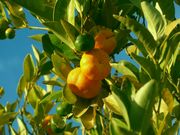   |
|
Cleopatra mandarin is the chota or billi kichili of India. The tree is attractive, round-topped, symmetrical, and thornless, with small, dark-green leaves. The fruit is orange-red, small, oblate, and highly depressed at the apex, with thin, somewhat rough rind. The flesh texture is soft and juicy and the flavour is somewhat acid. Considered to be native to India and said to have been introduced into Florida from Jamaica sometime prior to 1888, Citrus reshni is increasingly used as rootstock in the United States and elsewhere. It is an attractive ornamental and bears fruit the year round. Use as rootstock: Citrus reshni, often rererred to as Cleo, has some amount of use as rootstock in suitable areas like Texas where it is generally adapted to Valley conditions. It is more cold tolerant than sour orange and tolerant to tristeza, but is less tolerant to alkalinity. Trees on Cleopatra mandarin are slower to bear and yields, fruit size and quality are all poorer than those obtained on sour orange. Currently Cleo is not as commonly propagated as other rootstock types. Advantages: good fruit quality, suitable for shallow soils, salinity tolerant, tolerates soil alkalinity. Disadvantages: nematode sensitive, Phytophthora sensitive, slow to crop, smaller fruit size, sensitive to waterlogging, large tree size. |
||
| ENG | Cleopatra mandarin |
|
| Photo | (1-3)
© Jorma Koskinen (4) © Aggie Horticulture TAMU |
|
| LAT | Citrus macrophylla Wester Alemow |     |
| Syn | Citrus celebica × Citrus maxima |
|
|
Alemow is hybrid of Celebes papeda (Citrus celebica) with a another citrus species, probably a pomelo (Citrus maxima). It has been tried as a rootstock for lemons in California. This hybrid, named Citrus macrophylla by Wester is sometimes cultivated in Cebu, Philippine Islands. It has large leaves, with the blades 12 to 14 cm long and 6 to 8 cm wide, with much smaller, subtriangular, short-winged petioles, measuring up to 3.5 cm wide near the top. The fruits are very large, 8.5 to 10 cm in diameter, subglobose to oblong, more or less narrowed at the base, with a rough, transversely-corrugated, but rather thin skin. The fruit has 13 to 16 segments and rather dry, sour pulp, considered inedible even by the natives. Use as rootstock: Advantages: resistance to phytophthora (foot rot), flood tolerant, drought tolerant, blight tolerant, CEV tolerant, high yield, large fruit size, high vigour, alkalinity tolerant, good salt tolerance Disadvantages: low cold tolerance, low blight tolerance, tristezza susceptible, nematode susceptible |
||
| ENG | Alemow papeda | |
| Photos | © Gene Lester | |
|
|
||
| LAT | Citrus × jambhiri Lush. Rough lemon |    |
Cultivated varieties: ’Estes’, ’Milam’, 'McKillop' and 'Lockyer' |
||
Rough lemon. A recent study using molecular markers has shown Rough lemon to be a cross of mandarin and citron and thus a close relative of the Rangpur lime. It is believed to have originated in northern India, where it grows wild; carried in 1498 or later by Portuguese explorers to southeastern Africa where it became naturalized; soon taken to Europe, and brought by Spaniards to the New World. It is naturalized in the West Indies and Florida. Fruit oblate, rounded or oval, base flat to distinctly necked, apex rounded with a more or less sunken nipple; of medium size, averaging 2 3/4 in,(7 cm) wide, 2 1/2 (6.25 cm) high; peel lemon-yellow to orange-yellow, rough and irregular, with large oil glands. Tree is large, very thorny; new growth slightly tinged with red; buds and flowers with red-purple. The scant pulp and juice limit the rough lemon to home use. It is appreciated as a dooryard fruit tree in Hawaii and in other tropical and subtropical areas where better lemons are not available. Reproduces true from seeds. Use as rootstock: Rough lemon is a highly vigorous rootstock and shows good yield performance in early years. Rough lemon produces large trees with a large well developed root system. In wet conditions trees older than fifteen years often suffer from alternate bearing and declining yields. On sandy soils in drier areas rough lemon has stayed healthy and productive over forty years. Rough lemon is the quickest growing of all common rootstocks. It is also the easiest rootstock to propagate and has the longest propagation season. Due to their high vigour, nursery trees on Rough lemon have a high nutritional requirement. Trees on Rough lemon produce fruit with somewhat poorer internal quality due to low soluble solids and acid content. Rough lemon produces the earliest maturity of all common rootstocks due to the low fruit acidity. Juice content is also low and fruit from trees on Rough lemon often have a thicker, coarser textured rind. Advantages: fast growing, large fruit size, early maturing, drought tolerant, high yields, exocortis tolerant, tristeza tolerant. Disadvantages: Phytophthora sensitive, poor fruit quality, thick fruit rind, sensitive to waterlogging, large tree size. |
||
| ENG | Rough
lemon, Florida Rough, Jamberi, Citronelle |
|
| FRA | Citron verruqueux, Rough lemon | |
| GER | Rauhschalige Zitrone | |
| I TA | Rugoso | |
| SPA | Limón rugoso | |
| Photo | (1) © CINHP /
G.McCormack, with permission (2) © C. Jacquemond / INRA (3) CCPP |
|
| LAT | Citrus × limon (L.) Osbeck 'Volkamer' |
  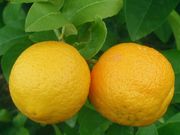
|
| Syn | Citrus volkameriana V.Ten. & Pasq. Citrus × limonia Osbeck 'Volkamer' |
|
The Volkamer lemon has been known for three centuries. It was first thought of as a cross of lemon and sour orange. Recently it has been found out to be a cross of citron and sour orange and thus a sister hybrid of the lemon and the Palestine sweet lime (see Citrus classification). Slightly smaller than lemon trees, it flowers and bears fruit profusely. This and the attractively dense foliage make it an excellent ornamental tree. The fruit are lemon-shaped, wide and with a rough, bright reddish rind. The flesh and juice are yellow-reddish colour. The fruit has few or no seeds, tastes slightly bitter and has a pleasantly fresh taste and aroma. It can be used in cooking instead of lemon. The Volkamer lemon is used as rootstock for other citrus types because of its resistance to many diseases. Use as rootstock: Advantages: Floot tolerant, drought tolerant, tristezza (CTV) tolerant, exocortis (CEV) tolerant, high yield, high vigour, salt tolerant, alkalinity tolerant, Disadvantages: phytophthora susceptible, low cold tolerance, low blight tolerance, nematode susceptilble, low sugar/solids, large tree size |
||
| ENG | Volkamer
lemon |
|
| FRA | Citron de Volkamer | |
| Photo | © Jorma Koskinen | |
| Link | ||
| LAT | Citrus × jambhiri Lush. 'Rangpur' |
     |
| Syn | Citrus × limonia var. rangpur Osbeck | |
Rangpur lime is today considered citron × mandarin cross. It is an Indian Mandarin lime variety. It has many closely related cultivars, which are described in Limes. The colour range varies. In spite of its mandarin-like appearance the taste is closer to lime. The tree is usually vigorous and productive, medium-sized, spreading and drooping, with slender twigs, comparatively few and small thorns. Foliage is dull-green and mandarin-like, and new shoot growth lightly purple-tinted. Flowers small and mandarin-like and buds and petals deeply purple-tinged. The trees bear a lot of fruit from November to early spring. In India 20 - 40 % of Rangpur juice is added to mandarin juice to improve its flavour. The Rangpur lime is most valuable as root stock for other citrus varieties. In addition, the Rangpur lime is considered a superior fruit for marmalade in the regions where it is grown. The flavour is said to surpass the flavour of both the Seville orange 'Sevillano' and the Bittersweet orange as a marmalade ingredient. In the United States the Rangpur lime is widely used as a hardy, dooryard fruit and ornamental and as a potted or tubbed plant. It is especially well adapted for such uses since it propagates readily from cuttings and is easily dwarfed when the roots are confined. Use as rootstock: Advantages: drought tolerant, (some) cold and blight tolerance, tristezza tolerant, high yield, large fruit size, high vigour, high alkalinity and salt tolerance. Disadvantages: phytophthora and exocortis susceptible, nematode susceptible, low sugar/solids The citrus industry of Brazil uses at least three different clones of Rangpur as rootstock: Limeira, Tatuatiringa and Santa Barbara from California. Recently a Brazilian nursery has introduced a new cultivar Citrolima, which in addition to being more vigorous is said to be resistant to scab and foot rot (phytophthora) as well. Rangpur lime is the most common rootstock (80%) in the Sao Paulo citrus industry. Trees on Rangpur lime are highly vigorous, resistant to drought, and adapt well to most soil types, even the more sandy and poor, where they can have excellent performance with nutritional complementation. Most of the orchards depend on rain for water and 60 to120 days without rain during the blooming period are common. The excellent drought resistance of Rangpur may be one of the reasons for its popularity. In São Paulo Rangpur lime is resistant to tristezza but susceptible to other diseases: exocortis, xyloporosis, foot rot, nematodes, blight, and sudden death (CSD virus). The effects of these diseases, however, can be minimized with special care during the production of the nursery plants. Citrus trees budded on Rangpur lime start bearing good crops after only 3 years. Rangpur lime induces early maturity on scion fruit and help growers to obtain better prices at the beginning of the season. |
||
| ENG | Rangpur
lime |
|
| FRA | Lime Rangpur | |
| GER | Rangpur Mandarinenlimette | |
| SPA | Lima rangpur | |
| IND | Sylhet lime, surkh nimboo, sharbati | |
| Photos | (1-2) © C. Jacquemond
/ INRA (3) © CCPP (5-6) © Jorma Koskinen |
|
|
|
|
|
| LAT | Citrus × limon (L.) Osbeck 'Palestine Sweet Lime' |
 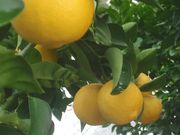  |
| Syn | Citrus
limettioides Tanaka |
|
Palestine sweet lime is a sweet lime that today is considered a citron × sour orange cross and thus a sister hybrid of the lemon and Volkamer lemon. One of the few limes that can be enjoyed fresh. In India the fruit are also cooked whole and eaten as a dessert or preserved either pickled or as a jam. The Palestinian coast and Egypt have long been areas where this sweet lime is traditionally grown. Also known as the Indian sweet lime. Cultivated varieties: ‘India’, ‘Columbia’, ‘Soh Synteng’ and ’Palestine’ Use as rootstock: Advantages: good flooding and drought tolerance, tristezza tolerant, high yield, large fruit size, high vigour, good alkalinity and salt tolerance Disadvantages: phytophthora, exocortis and nematode susceptible, low sugar/solids, low cold and blight tolerance |
||
| ENG | Palestine sweet lime, Palestinian lime, Indian sweet lime, Indian lime | |
| FRA | Lime douce de l'Inde, Lime douce India, Limettier doux | |
| GER | Palästinische Limette | |
| I TA | Limetta dolce dell’India | |
| SPA |
Lima dulce india, lima de Palestina | |
| IND | Mitha nimbu, mitha nebu, mitha limbu | |
| Photos | © Jorma Koskinen | |
| |
||
| LAT | Citrus sunki Tanaka Sour mandarin |   |
| Syn | Citrus reticulata var. austera Swingle | |
|
Sour mandarin is the sunki, suenkat or sunkat of South China. It is the Citrus reticulata var. austera of Swingle's classification that is in the pedigree of both Yuzu (Citrus junos) and Calamondin (Citrus × microcarpa). It is a medium-small, upright tree with distinctive pale-green leaves. The fruit is medium-small, oblate and markedly depressed at both ends, and with basal furrows. The rind is strong and spicy with a distinctive aroma. The flavour is acid, the fruit never becoming edible. Seeds are medium-large and plump. Citrus sunki is considered to be native to China and is a widely employed rootstock in China and Taiwan. Use as rootstock: Advantages: phytophthora tolerant, drought tolerant, cold tolerant, blight tolerant, tristezza tolerant, good yield, high sugar/solids, high vigour, alkalinity and salt tolerant. Disadvantages: low flooding tolerance, exocortis and nematode susceptible, small fruit size |
||
| Photo | © Petr Broža | |

|
|
Page updated 18 August 2014
Back to top of page
